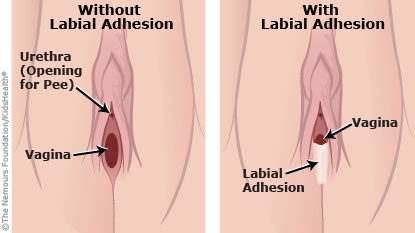Labial Adhesions
Also called: Labial Fusion, Labial Agglutination, Synechia Vulvae
What Are Labial Adhesions?
Labial adhesions happen when the labia minora (the inner folds of skin surrounding the vaginal opening) become fused together. In most cases, only a small part of the labia is fused, so the adhesions usually don’t cause any problems.
What Are the Signs & Symptoms of Labial Adhesions?
Often, the adhesions don’t cause any symptoms or problems. When they do, symptoms can include:
- getting many urinary tract infections (UTIs)
- trouble peeing, or dribbling pee
- vaginal discharge
- irritation in the area
How Are Labial Adhesions Diagnosed?
Most labial (LAY-bee-ul) adhesions are found by a doctor during a baby’s or young child’s routine health visit.

How Are Labial Adhesions Treated?
Labial adhesions will go away on their own during puberty if not well before that. They only need medical treatment if a large part of the labia is fused or the adhesions cause problems (such as trouble peeing or infections).
If treatment is needed, doctors prescribe an estrogen or steroid cream to help the adhesions come apart. It’s important to use just a small amount of the cream and put it only on the thin white line in the middle of the adhesions. Although it’s rare, using too much cream can cause side effects, such as irritation or skin color changes in the vaginal area, a small among of vaginal bleeding, or development of pubic hair or breast buds from the estrogen or skin thinning from the steroid. Don’t pull on the adhesions to try to pull them apart.
To prevent the labia from growing back together after the adhesions part, put white petroleum jelly on the area twice a day for 6–12 months. After your child finishes puberty, the labial adhesions aren't likely to come back.
Very rarely, doctors will need to do a simple surgery to separate the adhesions.
What Causes Labial Adhesions?
The exact cause of labial adhesions isn’t clear. In babies and females who haven't gone through puberty, the labia are very delicate and easily irritated. The adhesions may form as the body heals from irritation.
Because adhesions are less common after females go through puberty and estrogen levels rise, low estrogen levels likely play a role.
How Can Parents Help?
Because irritation to the labia can make the adhesions worse or cause them to come back:
- Keep the genital area clean:
- Babies: Change your baby’s diapers as soon as they get wet or soiled. Use plain water on a washcloth or fragrance-free wipes and wipe from front to back. Don’t use scented ointments or lotions.
- Potty-trained/older kids: Teach kids to wipe from front to back after using the toilet. They also should wash the area with plain water every day in the bath or shower.
- Avoid bubble baths and only use soap (fragrance-free) or shampoo at the end of a bath, then rinse well with plain water.
- Use mild, fragrance-free detergent for washing underpants and bathing suits. Don’t use fabric softener liquid or dryer sheets.
- Don’t let your child sit in a wet swimsuit for a long time.
- Your child should avoid tight clothing (such as leggings and tights) and should wear a nightgown or loose-fitting pajamas while sleeping.
When Should I Call the Doctor?
Call your doctor if:
- Your child has signs of an infection, such as pain when peeing, a fever, vaginal discharge, or belly pain.
- The labia don’t separate as expected (within 2 months if using an estrogen or steroid cream or by puberty if not using medicine).
- The labial adhesions go away and then come back.
- You are using the estrogen cream, and your child develops breast buds or pubic hair.
- You are using the steroid cream, and you notice skin changes in the genital area.
What Else Should I Know?
Labial adhesions do not cause any lasting problems. Later in life, they won’t affect your child’s sexuality or fertility (ability to have children).
